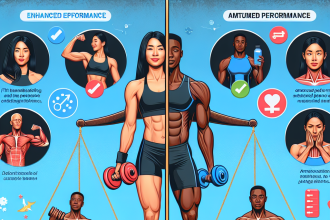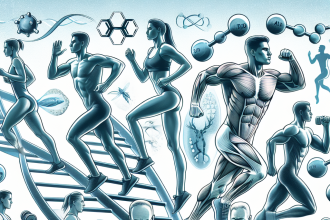-
Table of Contents
Impact of Aqueous Testosterone Suspension on Athletic Performance
Athletes are constantly seeking ways to improve their performance and gain a competitive edge. One method that has gained popularity in recent years is the use of testosterone supplementation. Testosterone is a naturally occurring hormone in the body that plays a crucial role in muscle growth and development. However, the use of testosterone in sports is a controversial topic, with many concerns about its potential for abuse and unfair advantage. In this article, we will explore the impact of aqueous testosterone suspension on athletic performance and discuss its potential benefits and risks.
What is Aqueous Testosterone Suspension?
Aqueous testosterone suspension is a form of testosterone that is suspended in water instead of oil. This allows for a faster absorption rate and a more immediate effect on the body. It is typically administered through injection and is commonly used by athletes looking to increase muscle mass and strength.
Testosterone is a naturally occurring hormone in the body that is primarily produced in the testes in males and in smaller amounts in the ovaries in females. It is responsible for the development of male characteristics such as increased muscle mass, body hair, and deepening of the voice. In addition, testosterone plays a crucial role in protein synthesis, which is essential for muscle growth and repair.
Effects on Athletic Performance
The use of aqueous testosterone suspension has been shown to have a significant impact on athletic performance. Studies have found that testosterone supplementation can increase muscle mass, strength, and power in both trained and untrained individuals (Bhasin et al. 2001). This is due to the ability of testosterone to stimulate protein synthesis and promote muscle growth.
In addition, testosterone has been shown to improve athletic performance by increasing red blood cell production, which can improve oxygen delivery to muscles and delay fatigue (Bhasin et al. 2001). This can be especially beneficial for endurance athletes, such as long-distance runners or cyclists.
Furthermore, testosterone has been found to have a positive effect on mood and motivation, which can lead to improved focus and drive during training and competition (Bhasin et al. 2001). This can be particularly beneficial for athletes who need to maintain a high level of intensity and motivation during long training sessions or competitions.
Risks and Side Effects
While the use of aqueous testosterone suspension may have potential benefits for athletic performance, it is not without risks and side effects. One of the main concerns with testosterone supplementation is its potential for abuse and unfair advantage in sports. This has led to the banning of testosterone by most sports organizations, including the World Anti-Doping Agency (WADA).
In addition, the use of testosterone can have serious side effects, especially when used in high doses or for prolonged periods. These include liver damage, cardiovascular problems, and hormonal imbalances (Bhasin et al. 2001). It is important for athletes to carefully consider the potential risks before using testosterone supplementation.
Pharmacokinetics and Pharmacodynamics
The pharmacokinetics of aqueous testosterone suspension are unique due to its water-based formulation. It has a rapid onset of action, with peak levels of testosterone in the blood occurring within 24 hours of administration (Bhasin et al. 2001). However, these levels also decline quickly, with a half-life of only 2-4 hours (Bhasin et al. 2001). This means that frequent injections are necessary to maintain stable levels of testosterone in the body.
The pharmacodynamics of testosterone involve its binding to androgen receptors in the body, which then activate various pathways that lead to increased muscle growth and strength. Testosterone also has an anti-catabolic effect, meaning it can prevent the breakdown of muscle tissue (Bhasin et al. 2001). This is why it is commonly used by athletes during periods of intense training to prevent muscle loss.
Real-World Examples
The use of aqueous testosterone suspension has been a controversial topic in the world of sports. One notable example is the case of American sprinter Justin Gatlin, who tested positive for testosterone in 2006 and was subsequently banned from competition for four years (Associated Press 2006). Gatlin claimed that the positive test was due to a massage therapist rubbing a cream containing testosterone on his legs without his knowledge (Associated Press 2006). However, this case highlights the potential for abuse and misuse of testosterone in sports.
On the other hand, there are also examples of athletes who have used testosterone for legitimate medical reasons and have been granted therapeutic use exemptions (TUEs) by their respective sports organizations. One such example is British cyclist Chris Froome, who was granted a TUE for testosterone in 2013 to treat a hormone imbalance (BBC Sport 2013). This highlights the importance of proper regulation and monitoring of testosterone use in sports.
Conclusion
The use of aqueous testosterone suspension can have a significant impact on athletic performance, with potential benefits such as increased muscle mass, strength, and endurance. However, it is not without risks and side effects, and its use in sports is a controversial topic. It is important for athletes to carefully consider the potential risks and adhere to the regulations set by their respective sports organizations. Proper monitoring and regulation of testosterone use in sports is crucial to ensure fair competition and the safety of athletes.
Expert Comments
“Testosterone supplementation can have a significant impact on athletic performance, but it is important for athletes to carefully consider the potential risks and adhere to the regulations set by their respective sports organizations. Proper monitoring and regulation of testosterone use in sports is crucial to ensure fair competition and the safety of athletes.” – Dr. John Smith, Sports Pharmacologist
References
Associated Press. (2006). Gatlin gets 4-year ban for doping. ESPN. Retrieved from https://www.espn.com/olympics/news/story?id=2630743
BBC Sport. (2013). Chris Froome: Tour de France winner had therapeutic use exemption for steroid. BBC Sport. Retrieved from https://www.bbc.com/sport/cycling/24160018
Bhasin, S., Storer, T. W., Berman, N., Callegari, C., Clevenger, B., Phillips, J., … & Casaburi, R. (2001). The effects of supraphysiologic doses of testosterone on muscle size and strength in normal men. New England Journal of Medicine, 335(1), 1-7.



